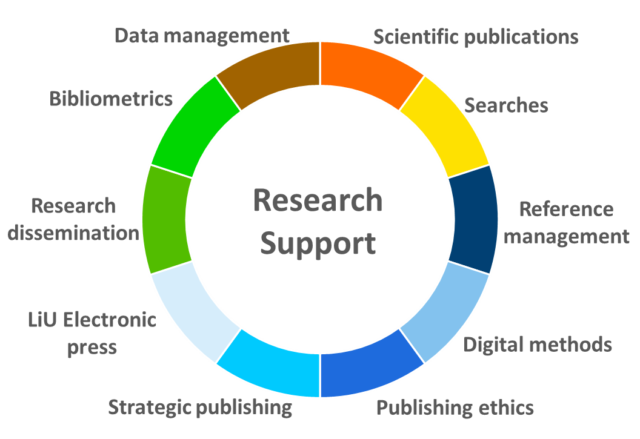** denna blogpost finns även på svenska **
Many researchers are reluctant to spend time on RG. It is perceived as time-consuming and the return on investment is unclear.
RG certainly requires some time, but time invested in creating and maintaining a RG-profile can be seen as an investment in your professional identity, your research and your publications. RG has, according to a blogpost in the influential Scholarly Kitchen, a significantly higher traffic than Google Scholar. Being visible on RG is thus a good and effective measure to be read (and also, by extension) to be cited.
If you do not have the time to read this blogpost in its entirety – don’t worry. A short checklist is presented at the end.
What is RG?
RG can be described as a social network for researchers – sometimes referred to as an ASNS (Academic social network site). It provides the (free) opportunity to create a research profile. According to RG more than 125 million members have done so. RG is a commercial enterprise with an unclear business model. It is thus not clear how they make money out of the information on their site. It is also interesting to note that RG is an enterprise focused on its ASNS in an industry characterized by few actors who have interests throughout the entire research process.
2 reasons why you should spend time on RG
Spending time strategically on creating a research profile meets two important missions:
RG is a visible storefront for your research. Many of the fulltexts linked from Google Scholar comes from RG. This is positive – but also, as I will come back to, highly problematic.
A time-efficient way to network. If you state your research interests and present your research, you provide the opportunity for other researchers to find you and your research . The networking side of RG is thus a good complement to conferences.
3 ways in which RG may increase your visibility
RG contains many functionalities. This blogpost focuses on the functions which I believe are the most important for increasing the visibility of your publications and research.
1. A storefront for your professional identity. Fill in your RG -profile. The profile is found under “my profile” and then “info”. If you have a Twitter-account, make sure to fill in your Twitter name. Extra important is to fill in your ORCID and uploading an image of yourself. This will strengthen your professional identity.
2. A compelling list of publications. Many sites offer researchers to set up a research profile. Usually you enter data about your publications (eg by entering their references). At RG you are asked to upload the publications instead. RG states that you can upload the publications publicly or privately. Think carefully about the potential consequences of uploading your articles!
Researchers often lack copyright of their own articles and are thus often prohibited to upload their own articles. If you are a LiU-researcher you have access to Publication Visibility which helps you to distinguish exactly which of your own articles you are actually allowed to upload publicly on RG. They are rather rare! The flowchart below provides decision support.

3. How do you want to use RG as a networking tool?
Who do you wish would comment upon your research? You can ask peers to comment upon your research.This option can be used strategically, but it is nevertheless important not to spam your peers.
Creating “projects” showcase current research and provide a strategic opportunity to network with followers. Three examples of projects which might inspire are Effective and efficient emergency response at the incident site of tomorrow,GREENFLEET and Seeing organ function.
If you are a research leader you have yet one opportunity to showcase your research: the lab. A lab consists of a research group and may be created by the research leader. You can only be part of one lab. Use the lab function to showcase the current work of the research group and how it evolves between publications.
How do I get started?
RG is fun. Follow its logic! A checklist may be useful in order to use time wisely and prevent unintentional copyright infringement. The library research support is there for you if you want extra input.
- Invest four minutes in the University of the Bahamas clip and ponder on your reason for being on RG.
- Fill out your profile. Don´t forget ORCID and an image of yourself.
- Take point of departure in your latest list of publications and see how you may showcase your publications. Think carefully before uploading a fulltext on RG! If you are a productive researcher you might want to limit yourselves to showcasing articles. PubVis helps you to decide which fulltexts to upload publicly on RG and it also helps you to create title pages if uploading the fulltext is not advisable. Kudos offers a similar service if you do not have access to PubVis.
- Who do you want to follow (and why?) RG, just as social medias in general, builds upon the identification of followers.
- Do you have research that you want to showcase in a project? Identify the project collaborators, add a description of the project and the publications it includes. Decide upon the type of content you want to add in the future and how often you want to update your project.
Most importantly…
Dusty storefronts are a cardinal sin. It is easy to make one selective measure and then leave the research profile to its own devices. Make sure to make a plan now outlining when you revise and update your RG-profile. Through doing so you make RG an integral part of your scholarly communication.
This blogpost has focused on one type of publications: articles. It has not even mentioned books, conference papers, chapters in edited books, nor preprints or research data. There is more, lots more, to discover at the commercial ASNS.
Written by Johanna Nählinder, co-ordinator of research support LiUB

